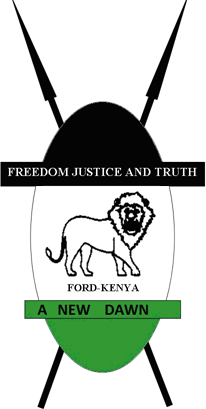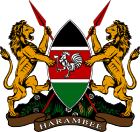
The politics of Kenya take place in a framework of a presidential representative democratic republic, whereby the president is both head of state and head of government, and of a multi-party system in accordance with a new constitution passed in 2010.

The Kenya African National Union (KANU) is a Kenyan political party that ruled for nearly 40 years after Kenya's independence from British colonial rule in 1963 until its electoral loss in 2002. It was known as Kenya African Union (KAU) from 1944 but due to pressure from the colonial government, KAU changed its name to Kenya African Study Union (KASU) mainly because all political parties were banned in 1939 following the start of the Second World War. In 1946 KASU rebranded itself into KAU following the resignation of Harry Thuku as president due to internal differences between the moderates who wanted peaceful negotiations and the militants who wanted to use force, the latter forming the Aanake a forty, which later became the Mau Mau. His post was then occupied by James Gichuru, who stepped down for Jomo Kenyatta in 1947 as president of KAU. The KAU was banned by the colonial government from 1952 to 1960. It was re-established by James Gichuru in 1960 and renamed KANU on 14 May 1960 after a merger with Tom Mboya's Kenya Independence Movement.

The National Rainbow Coalition (NARC) is a political party in Kenya. As an alliance, it was in power from 2002 and 2005 when it collapsed due to disagreements between members over a constitutional referendum.

Emilio Mwai Kibaki was a Kenyan politician who served as the third President of Kenya from December 2002 until April 2013.

Uhuru Muigai Kenyatta is a Kenyan politician who served as the fourth president of Kenya from 2013 to 2022.

Stephen Kalonzo Musyoka is a Kenyan politician who was the tenth Vice-President of Kenya from 2008 to 2013. Musyoka served in the government under the late President Daniel arap Moi as the Secretary of Kenya African National Union party (1980-1988), Assistant Minister for Works (1986-1988), Deputy Speaker of the National Assembly (1988-1992), Minister for Foreign Affairs from 1993 until 1998, Minister of Education (1998-2001); and subsequently, under the late President Mwai Kibaki, he was Minister of Foreign Affairs again from 2003 to 2004, then Minister of the Environment from 2004 to 2005. He was an unsuccessful candidate in the 2007 presidential election, after which he was appointed vice-president by Kibaki in January 2008.
The Liberal Democratic Party was a political party in Kenya.

Elections in Kenya take place within the framework of a multi-party democracy and a presidential system. The President, Senate and National Assembly are directly elected by voters, with elections organised by the Independent Electoral and Boundaries Commission (IEBC).

Forum for the Restoration of Democracy–Kenya (FORD–Kenya) is a Kenyan political party. The party has sat in the government of Kenya once, under the National Rainbow Coalition, from 2003 to 2007, having ended forty years of one party rule. In April 2022, the party joined the Kenya Kwanza coalition for the August 2022 elections, and is headed by Moses Wetangula, the current speaker of the National Assembly of Kenya

Michael Christopher Kijana Wamalwa was a renowned Kenyan politician who at the time of his death was serving as the eighth Vice-President of Kenya.
Wycliffe Musalia Mudavadi is a Kenyan politician and land economist who is currently serving as the Prime Cabinet Secretary of Kenya. Until October 2022, he was also the party leader of the Amani National Congress (ANC), one of the founding political parties, of the Kenya Kwanza alliance. He served as the 7th Vice-President of Kenya in 2002 and Deputy Prime Minister (2008–2012), when he resigned to contest for the Presidency in the 2013 Kenyan general election and emerged third. He was the deputy party leader of the Orange Democratic Movement (ODM) (2005–2012) and Party Leader of the United Democratic Forum Party (UDF) from May 2012 to July 2015.

Raila Amolo Odinga is a Kenyan politician who served as the prime minister of Kenya from 2008 to 2013. He served as the Member of Parliament (MP) for Langata Constituency from 1992 to 2013 and has been the Leader of Opposition in Kenya since 2013. He is the leader of Azimio la Umoja–One Kenya Coalition Party.

The deputy president of the Republic of Kenya is the principal assistant of the President of the Republic of Kenya.
The Orange Democratic Movement (ODM) is a centre-left political party in Kenya. It is the successor of a grassroots people's movement which was formed during the 2005 Kenyan constitutional referendum campaign. This movement separated in August 2007 into the Orange Democratic Movement Party of Kenya and the Wiper Democratic Movement – Kenya.

George Musengi Saitoti, E.G.H. was a Kenyan politician, businessman and American- and British-trained economist, mathematician and development policy thinker.

John Njoroge Michuki was a Kenyan politician and businessman. He was born at Muguru, village, Iyego Location, Kangema Division in Murang’a District. He was educated in Kenya and abroad. Michuki emerged as one of the prominent and long-serving civil servants and politicians as well as a businessman in Kenya. Michuki served Kenya in various capacities, including Permanent Secretary in the Finance Ministry, Chairman of the Kenya Commercial Bank, Member of Parliament and Cabinet Minister. He was serving his 4th five-year term as a Member of Parliament for Kangema Constituency. Michuki had a reputation as a "ruthless" and efficient manager, and was widely acknowledged as among the best performing ministers in President Kibaki's Government. He was serving as the Minister for Environment and National Resources at the time of his death.

The Party of National Unity (PNU) is a political party in Kenya originally founded as a political coalition. On 16 September 2007, Kenyan President Mwai Kibaki announced the party formation and said that he would run as its presidential candidate in the December 2007 Kenyan elections. It has since become a political party in its own right following conditions set by the Political Parties Act, passed in Kenya in 2008. Recently PNU has launched activities to revamp itself ahead of the 2022 general elections.

General elections were held in Kenya on 27 December 2007. Voters elected the President, and members of the National Assembly. They coincided with the 2007 Kenyan local elections.
The 9th Parliament of the Republic of Kenya was opened by elected President Mwai Kibaki on February 18, 2003. It was the first time that the formerly-dominant Kenya African National Union of Daniel arap Moi was in the minority. The triumphant NARC, which dominated in the general elections of 2002 was in the majority, led by Kibaki.

The National Alliance (TNA) was a political party in Kenya. It took on its current identity when Uhuru Kenyatta assumed control and renamed it as the vehicle for his 2012 presidential campaign.


















